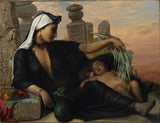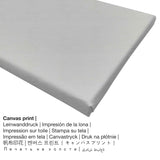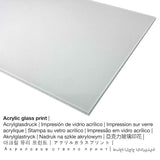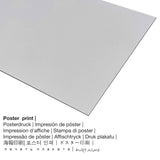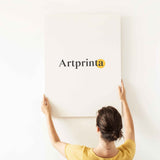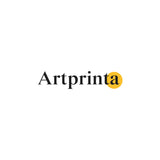Elisabeth Jericau-Baumann, 1872 - Mwanamke Fellah wa Misri akiwa na Mtoto wake - picha nzuri ya sanaa
Kodi ni pamoja. Usafirishaji umehesabiwa katika Checkout.
Maelezo ya usuli wa bidhaa
Ya zaidi 140 mchoro wa mwaka mmoja uliundwa na kweli master Elisabeth Jerichau-Baumann. This artwork belongs to the art collection of Makumbusho ya Statens ya Kunst (Matunzio ya Kitaifa ya Denmark), which is the largest museum of fine arts in Denmark and is attached to the Danish Ministry of Culture.. The modern art public domain artpiece is being provided with courtesy of National Gallery of Denmark.The creditline of the artwork is: . What is more, the alignment of the digital reproduction is landscape and has an aspect ratio of 4: 3, ambayo ina maana kwamba urefu ni 33% zaidi ya upana. The painter Elisabeth Jerichau-Baumann was a European artist from Denmark, whose style can mainly be classified as Realism. The Realist artist lived for miaka 62, born in the year 1819 in Warsaw and died in 1881 in Copenhagen.
Chagua chaguo lako bora la nyenzo za uchapishaji wa sanaa
Kwa kila uchapishaji mzuri wa sanaa tunatoa vifaa na saizi tofauti. Ili kuendana na mahitaji yako ya kibinafsi kikamilifu, unaweza kuchagua kati ya chaguo zifuatazo za ubinafsishaji wa bidhaa:
- Turubai: The printed canvas, which shall not be mistaken with an artwork painted on a canvas, is a digital copy printed from a UV direct printing machine. The great advantage of canvas prints is that they are relatively low in weight, meaning that it is easy to hang up the Canvas print without additional wall-mounts. That is why, a canvas print is suited for any kind of wall in your house.
- Uchapishaji wa glasi ya akriliki (na mipako halisi ya glasi): A glossy acrylic glass print, often denoted as a UV print on plexiglass, changes your favorite artwork into wonderful décor and forms a good alternative option to dibond and canvas fine art replicas. The major advantage of an acrylic glass art print is that sharp contrasts as well as granular color details will be identifiable due to the fine tonal gradation.
- Mchapishaji wa dibond ya Alumini: Aluminium Dibond prints are metal prints with a true depth effect - for a modern look and a non-reflective surface structure. For our Print On Aluminum Dibond, we print the artwork on the surface of the white-primed aluminum material. The bright & white components of the work of art shine with a silky gloss but without the glare. The colors are bright and luminous in the highest definition, the fine details of the print appear clear and crisp.
- Bango kwenye nyenzo za turubai: The poster is a printed sheet of canvas paper with a slightly rough structure on the surface. Please keep in mind, that depending on the size of the poster print we add a white margin of something between 2-6cm round about the artwork, which facilitates the framing with your custom frame.
Important information: We try what we can in order to describe the products as precisely as possible and to exhibit them visually in our shop. However, the pigments of the print products and the print result can differ to a certain extent from the representation on the device's screen. Depending on your screen settings and the condition of the surface, color pigments may not be printed as realistically as the digital version. Considering that all art prints are processed and printed manually, there may also be slight discrepancies in the motif's exact position and the size.
Maelezo ya kipengee kilichopangwa
| Chapisha aina ya bidhaa: | uzazi wa sanaa |
| Uzazi: | uzazi wa kidijitali |
| Mbinu ya utengenezaji: | uchapishaji wa dijiti |
| Asili ya Bidhaa: | kufanywa nchini Ujerumani |
| Aina ya hisa: | uzalishaji kwa mahitaji |
| Matumizi yaliyokusudiwa ya bidhaa: | mapambo ya nyumbani, mapambo ya ukuta |
| Mwelekeo wa picha: | mpangilio wa mazingira |
| Uwiano wa picha: | urefu hadi upana 4: 3 |
| Kidokezo: | urefu ni 33% zaidi ya upana |
| Chaguo zilizopo: | chapa ya glasi ya akriliki (yenye mipako halisi ya glasi), chapa ya bango (karatasi ya turubai), chapa ya chuma (dibond ya alumini), chapa ya turubai |
| Turubai kwenye fremu ya machela (chapisho la turubai) lahaja za ukubwa: | 40x30cm - 16x12", 80x60cm - 31x24", 120x90cm - 47x35", 160x120cm - 63x47" |
| Uchapishaji wa glasi ya Acrylic (na mipako halisi ya glasi): | 40x30cm - 16x12", 80x60cm - 31x24", 120x90cm - 47x35", 160x120cm - 63x47" |
| Chaguzi za ukubwa wa uchapishaji wa bango (karatasi ya turubai): | 40x30cm - 16x12", 80x60cm - 31x24", 120x90cm - 47x35" |
| Ukubwa wa kuchapisha alumini (nyenzo ya dibond ya alumini): | 40x30cm - 16x12", 80x60cm - 31x24", 120x90cm - 47x35" |
| Muafaka wa picha: | haipatikani |
Maelezo ya usuli wa kazi ya sanaa
| Jina la sanaa: | "An Egyptian Fellah Woman with her Baby" |
| Uainishaji: | uchoraji |
| Kategoria ya jumla: | sanaa ya kisasa |
| Uainishaji wa muda: | 19th karne |
| Mwaka wa kazi ya sanaa: | 1872 |
| Takriban umri wa kazi ya sanaa: | miaka 140 |
| Imeonyeshwa katika: | Makumbusho ya Statens ya Kunst (Matunzio ya Kitaifa ya Denmark) |
| Mahali pa makumbusho: | Copenhagen, Denmark |
| Inapatikana kwa: | Makumbusho ya Statens ya Kunst (Matunzio ya Kitaifa ya Denmark) |
| Aina ya leseni ya mchoro: | Uwanja wa umma |
| Kwa hisani ya: | Matunzio ya Kitaifa ya Denmark |
Jedwali la muhtasari wa msanii
| Jina la msanii: | Elisabeth Jericau-Baumann |
| Jinsia ya msanii: | kiume |
| Raia wa msanii: | danish |
| Kazi: | mchoraji |
| Nchi ya msanii: | Denmark |
| Kategoria ya msanii: | msanii wa kisasa |
| Mitindo ya sanaa: | uhalisia |
| Alikufa akiwa na umri: | miaka 62 |
| Mwaka wa kuzaliwa: | 1819 |
| Mahali: | Warszawa |
| Mwaka wa kifo: | 1881 |
| Alikufa katika (mahali): | Copenhagen |
© Hakimiliki ya, Artprinta.com (Artprinta)
General information from Statens Museum for Kunst (National Gallery of Denmark) (© Copyright - by Statens Museum for Kunst (National Gallery of Denmark) - Makumbusho ya Statens ya Kunst (Matunzio ya Kitaifa ya Denmark))
Baumann was a rare artist in her own day. Partly because she was a woman, but also because of her unusual openness towards the exotic and the unknown. This painting is an excellent example of Baumann’s keen sense for the erotic and the sensuous.
This painting of an Egyptian farm worker is among the most striking of Jerichau Baumann’s oriental scenes. The nudity beneath the sheer silk fabric, the exotic jewellery, the reddening evening sky, and the dark colours all infuse it with a sensuous quality that must have had a strong impact in the 1870s, a time when the body was still viewed with suspicion.
Indeed, Elisabeth Jerichau Baumann occupies a unique position within Danish post-1850 art in more ways than one. Hailing from a Polish-German background, she had a wider horizon than most Danish artists, who would primarily strive to identify and cultivate the uniquely Danish. She had an openness to all things foreign and exotic that was rarely seen in Denmark at the time; her only real match in that regard would be Hans Christian Andersen. The wanderlust of an artist took her to Turkey, Greece, and Egypt (1869-70 and 1874-75), furnishing her with a rich fount of oriental motifs.
The museum also provides interactive and video material for this artwork.

